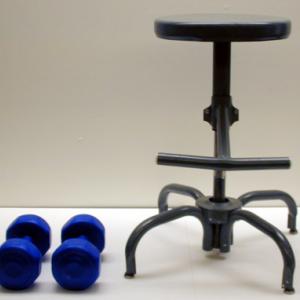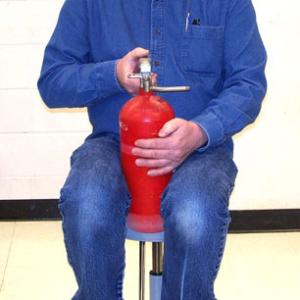College of Liberal Arts & Sciences
1Q40.10 - Cons. of Angular Momentum Demo - Stool and Weights
Don't spin the stool too fast when you use it as it will throw you off if you start out too fast. Practice is advisable.
Rotational motion can also be achieved by using the special demonstration fire extinguishers with the tube that can be pointed in different directions. You can slow down the rate of rotation by stopping the fire extinguisher discharge and extending your hands while holding the fire extinguisher.
Note that a regular fire extinguisher will not work for this demonstration.
- Alan DeWeerd, Eric Hill, "Conservation of Angular Momentum with a 3D-Printed Launcher", TPT, Vol. 62, #5, May 2024, p. 340.
- James Lincoln, "Get Dizzy: A Kinesthetic Lab on Angular Speed", TPT, Vol. 60, #4, April 2022, p. 314.
- Richard D. Kaufman, "Angular Acceleration Without Torque?", TPT, Vol. 50, # 1, Jan. 2012, p. 35.
- M. Boutinquiza, F. Lusquinos, "Simple Experimental Setup to Consolidate the Angular Momentum Concept", TPT, Vol. 49, # 7, Oct. 2011, p. 456.
- "Figuring Physics", TPT, Vol. 47, # 1, Jan. 2009, p. 52.
- Robert Johns. "Acceleration Without Force?", TPT, Vol. 41, # 3, p. 156 March 2003.
- Arthur Bryant, "Rotating Stool Mounted on a Low-Friction Hub", TPT, Vol. 38, # 8, p. 476, Nov. 2000.
- Arnold Arons, "An F = ma Analysis of the Spinning Skater and Decaying Satellite Orbit", TPT, Vol. 37, # 3, p. 154, March 1999.
- Nathaniel R. Greene, "A Low-Friction Rotator from the Junkyard", TPT, Vol. 35, # 7, p. 431, Oct. 1997.
- Richard S. Halada, "Mystery, Physics, Logic, and Coffee Cans", TPT, Vol. 29, # 4, p. 242, April 1991.
- Donald Maloney, 'The Moment of Inertia of Alex Meyer", TPT, Vol. 28, # 2, Feb. 1990, p. 100.
- Richard E. Berg and Robert E. Anders, "Angular Momentum Conservation Demonstration", TPT, Vol. 27, # 7, p. 561, October 1989.
- "Rotational Motion Demonstrator", TPT, Vol. 26, # 3, p. 187, March 1988.
- Robert B. Prigo and Melissa Reading, "Quantitative Angular Momentum Experiment On The Rotating Chair", AJP, Vol. 45, # 7, July 1977, p. 636.
- Mt- 2, Freier and Anderson, A Demonstration Handbook for Physics.
- M- 764, "Bike Wheel-Mass in Ext'd Hands", DICK and RAE Physics Demo Notebook.
- 50 Fun Experiments for the Mad Scientist in You, "Ice-Skater Effect", National Geographic Kids, p. 120.
- Robert Ehrlich, "F.2, Spinning Person on a Lazy Susan", Turn the World Inside Out, p. 67.
- Martin Gardner, "18, The Twirled Ring", Smart Science Tricks, p. 35.
- Borislaw Bilash II, David Maiullo, "Spin'em Up", A Demo a Day: A Year of Physics Demonstrations, p. 166.
- Jearl Walker, "1.95, Spinning Ice-Skater", The Flying Circus of Physics Ed. 2, p. 47.
- "The Einstein- De-Haas Effect", Informal Comments, Bob Williamson, Oakland University, Oct. 2002.
- Raymond Bruman, "Momentum Machine", Exploratorium Cookbook I, p. 74-1 - 74-4.
- Samuel Hokin, "Figure Skating Spins, bsharp.org, Oct. 2016.
Disclaimer: These demonstrations are provided only for illustrative use by persons affiliated with The University of Iowa and only under the direction of a trained instructor or physicist. The University of Iowa is not responsible for demonstrations performed by those using their own equipment or who choose to use this reference material for their own purpose. The demonstrations included here are within the public domain and can be found in materials contained in libraries, bookstores, and through electronic sources. Performing all or any portion of any of these demonstrations, with or without revisions not depicted here entails inherent risks. These risks include, without limitation, bodily injury (and possibly death), including risks to health that may be temporary or permanent and that may exacerbate a pre-existing medical condition; and property loss or damage. Anyone performing any part of these demonstrations, even with revisions, knowingly and voluntarily assumes all risks associated with them.

